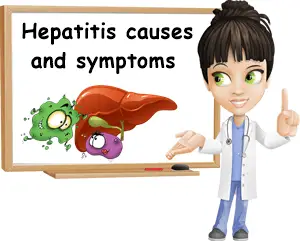Hepatitis is a liver disease that causes the inflammation of the liver tissue. The most common symptom associated with the disease is jaundice, or the yellowing of the whites of the eyes and skin. For the most part, hepatitis is an infectious disease and is caused by hepatitis viruses A, B, C, D or E. Other causes include bacterial or parasitic infections, contact with contaminated blood, auto-immune conditions or genetic disorders, chronic alcoholism, liver injury as a result of certain medication or herbal supplements and fatty liver disease.
What is hepatitis? Simply put, hepatitis is the inflammation of the liver. It can occur with or without symptoms and is an infectious disease. Hepatitis can be classified according to the causative agent, nature of the infection and duration. Treatment options and outcomes may differ depending on the agent causing the infection. Hepatitis can resolve itself or require treatment. The earlier it is detected and the faster treatment is initiated, the better the outcome. Leaving hepatitis untreated leads to liver scarring and cirrhosis, with complications such as liver cancer and liver failure.

Hepatitis types: acute and chronic. A first classification of hepatitis regards its duration. Acute hepatitis is hepatitis that resolves in less than 6 months, often by itself. Acute hepatitis can progress and become chronic in a small percentage of individuals. Chronic hepatitis is long-term hepatitis and requires medical treatment. Hepatitis A is often acute. Hepatitis B and D can be acute or chronic. Hepatitis C is chronic and known to progress to liver cirrhosis. Hepatitis D occurs together with hepatitis B. Hepatitis E is acute. Fulminant hepatitis causes a sudden liver cell death and is life threatening.
What are the symptoms of hepatitis?
The following are common signs and symptoms you have hepatitis:
1) Jaundice, a discoloration of the skin and mucous membranes that causes yellowing such as yellow skin and yellow whites of the eyes, stools colored like clay.
2) Flu-like symptoms: tiredness, nausea, fever, headaches, loss of appetite, vomiting.
3) Enlarged liver and spleen.
4) Pain in the right part of the upper abdomen, joint pain and aches.
5) Weight loss, less visible in acute hepatitis, more noticeable in chronic cases.
6) Allergy-like symptoms such as itching or rashes (common in autoimmune hepatitis).
7) Bruising and bleeding (signs of impaired liver function as a result of liver damage).
8) Swelling of the legs and abdomen (signs of advanced disease).
Some people are asymptomatic, meaning they do not present symptoms, but are infectious.
Types of viral hepatitis
The following are the main types of viral hepatitis with their characteristic symptoms and classified according to the virus causing the infection:
1) Hepatitis A. It is caused by the hepatitis A virus (HAV) and commonly transmitted through contact with an infected person, contaminated blood, food and water contaminated with stool matter, improperly cooked food, especially shellfish. Symptoms appear 2 to 6 weeks following infection and include flu-like symptoms such as fever, nausea, loss of appetite, vomiting, diarrhea, jaundice, abdominal pain. There is no treatment, but there is an effective vaccine for hepatitis A prevention. Bed rest is recommended for recovery as well as a good diet and drinking plenty of liquids.
Hepatitis A usually resolves itself in about 2 months and rarely progresses to liver damage and other complications (fulminant hepatitis). Children, pregnant women and the elderly are common risk categories for complications. Having the infection or getting vaccinated for it offers immunity against the virus.
Prevention for hepatitis A: This includes a good hygiene, especially washing hands regularly, cooking food well, avoiding direct contact with infected persons or their blood, drinking clean water and getting the hepatitis A vaccine.

2) Hepatitis B. It is a viral form of hepatitis caused by the hepatitis B virus (HBV). It is probably the most common form of the disease and can be both acute and chronic. It is estimated that about 350 million people worldwide have chronic hepatitis B. Hepatitis B can be transmitted via infected blood or other fluids from the body, as well as during childbirth from mother to child. In a healthy person, it is transmitted when infected blood of fluids come into contact with various lesions including open wounds, injuries, bites, ulcers, cuts. While some people are asymptomatic, others present symptoms such as jaundice, loss of appetite, nausea and vomiting.
Children are more likely to suffer complications and the younger the age of infection, the higher the chances of developing a chronic form that can progress to cirrhosis and liver cancer over time. Having hepatitis B puts you at risk of developing hepatitis D as well.
Prevention for hepatitis B is achieved primarily with good hygiene and comprises everything from simple aspects such as washing hands to practicing safety and sanitation in all aspects of one’s life. The hepatitis B vaccine offers excellent protection and immunity against the virus.
3) Hepatitis C. It is a viral form of hepatitis caused by the hepatitis C virus (HCV). It is estimated that 15 to 20% of hepatitis C infections are acute, while up to 75 or 80% are chronic. The chronic forms are known to progress to cirrhosis and other complications (liver cancer, hepatic coma) over time. Hepatitis C is transmitted similar to hepatitis B. Treatment includes antiviral medication. There is no vaccine for hepatitis C and symptoms of an infection are often mild or non-existent, hiding the progression of the disease.
Prevention for hepatitis C: avoid sharing toothbrushes, razors, manicure or pedicure tools and other items for personal hygiene. Practice safety and good hygiene in all aspects of your lifestyle. Any form of equipment that comes into contact with blood or other fluids should be sterile.
4) Hepatitis D. Hepatitis D is a viral infection caused by the hepatitis D virus (HDV). It only occurs together with hepatitis B and poses great risks. Having hepatitis D increases the chances of fulminant hepatitis and liver failure for acute hepatitis B infection. Hepatitis D also worsens chronic hepatitis B, determining a faster progression towards liver cirrhosis and cancer.
Prevention for hepatitis D: Getting the hepatitis B vaccine protects against both hepatitis B and D.
5) Hepatitis E. It is a viral infection caused by the hepatitis E virus (HEV). It is quite similar to hepatitis A and is transmitted most often via food and water contaminated with stool matter. Acute hepatitis E is the most common form, with symptoms such as fatigue, loss of appetite, nausea, jaundice etc. Treatment may include antiviral medication and requires bed rest, a good diet and drinking plenty of liquids. Certain categories of people are at risk of developing a severe form of the disease.
Pregnant women may develop fulminant hepatitis E, which is life-threatening for both mother and child. HIV patients and patients on anti-rejection medication in particular are at risk of developing a chronic form of hepatitis E which can progress to cirrhosis.
Prevention for hepatitis E includes good personal hygiene, access to clean water, cooking food thoroughly, appropriate disposal of waste material. There is currently only one hepatitis E vaccine, available in China. Others, although having passed trials, have not been made available for the general population.
Other types of hepatitis include:
6) Auto-immune hepatitis (can be acute, fulminant or chronic).
7) Bacterial hepatitis (can be caused by Escherichia, Salmonella and other bacteria).
8) Alcoholic hepatitis (caused by long-term alcohol consumption).
9) Hepatitis caused by medicines or other toxins. Medicines like paracetamol, various herbs and environmental toxins are toxic for the liver and can damage liver cells, causing inflammation of the organ and hepatitis.
10) Parasitic hepatitis (caused by parasites such as the common liver fluke, Fasciola hepatica, or the Chinese liver fluke, Clonorchis sinensis).
11) Hepatitis caused by: fatty liver diseases, genetic predisposition, obesity, metabolic syndrome, insulin resistance etc.
What does hepatitis do?
Hepatitis is a serious disease with major potential health effects. If left untreated, it can progress and become fulminant or chronic. Chronic hepatitis can evolve into cirrhosis, liver cancer and cause liver failure, hepatic coma and other severe complications like pancreatitis, inflammation of the heart muscle etc. Obesity, diabetes, fatty liver diseases are aggravating factors for hepatitis. Prevention is a crucial aspect and maintaining good hygiene, vaccinating for hepatitis A and B, washing and cooking food properly, having access to clean water, practicing safety in all aspects of one’s lifestyle are recommended.
